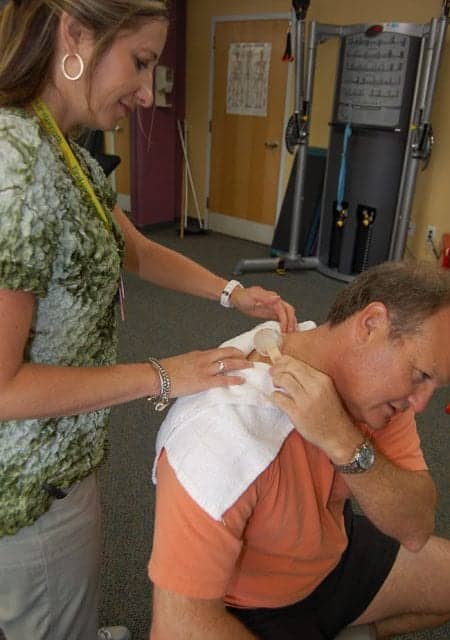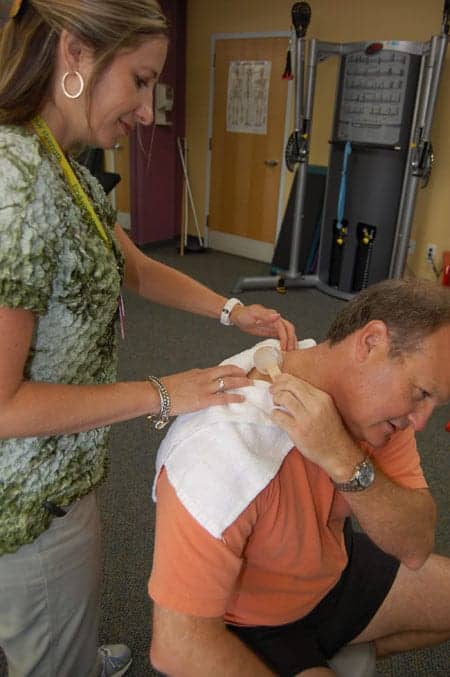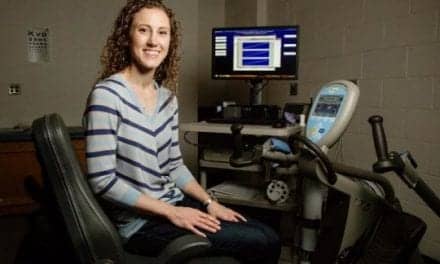Experience and the literature point to solutions that work.
by Eve Kennedy-Spaien, OTR/L, Dianne Kohlhofer, PT,
and Roberta Brehm, PT/s
As therapists, one of the most difficult challenges is working with the patient who has unrelenting pain. Research has shown that interdisciplinary pain management is more effective than single discipline approaches in improving the quality of life for people with chronic pain.1 Spaulding Rehabilitation’s Outpatient Center in Medford, Mass, provides coordinated interdisciplinary pain rehabilitation emphasizing functional improvement. Treatment integrates medical, physical, and cognitive-behavioral approaches to pain management. The emphasis is on self-management; clients learn strategies to better manage pain and return to the activities that are truly important to them.
A large portion of patients treated at this clinic have a variety of chronic low back pain (CLBP) conditions. More than 20 years ago, when we began working in the field of chronic pain, the clinic was located on an inpatient pain unit. The intensive, 4-week admission focused on medication management and tapering, physical conditioning, and education in pain management techniques. As reimbursement has changed, many inpatient pain programs have closed. Patients suffering from chronic pain are now being seen on an outpatient basis. This facility continues to provide treatment as one of the few remaining outpatient interdisciplinary pain programs. Following is the protocol the outpatient center uses to treat chronic pain, based on actual experience and evidence from the literature, to help enhance outcomes for patients affected by chronic back pain.
The Evaluation—Setting the Stage
Under this program, the most important part of the evaluation is establishing clearly that therapy will be collaborative. Therapy will provide patients with strategies to care for their pain and body. First, it must be determined why the patient has come, what the goals are, and what the patient’s past experience with health care has been. It is important to identify what has and has not been beneficial in the past and consider what the patient’s follow-through has been with previous treatments.
The physical therapy evaluation looks at the person as a whole, not specifically the back and trunk. In addition to the standard physical therapy evaluation, the quality of movement and body awareness also is assessed. If the patient is extremely kinesiophobic (fearful of movement), formalized testing may be deferred. Helping the patient feel safe during the evaluation is paramount.
An occupational therapist specialized in pain management assesses the patient’s ability to perform all activities of daily living. The OT looks not only at the ability to perform a task, but assesses how the patient is completing it. Also, the therapist evaluates movement patterns during activity, muscle guarding, and use of pain coping techniques. These techniques can include pacing, energy conservation, body mechanics, ergonomics, and integration of thermal modalities. The OT works with patients to identify functional goals and develop a plan to help them get back to the activities they value without increasing their pain.
Plan of Care—Therapeutic Progression and Clinical Reasoning
Individuals affected by chronic pain feel out of control. Therefore, the patient must actively participate in establishing the plan of care so they can reestablish control. The first few visits emphasize pain management. This is done primarily by teaching self-management tools, such as independent use of heat and ice, self-massage, and relaxation/muscle tension reduction techniques. Therapists utilize passive modalities sparingly. Corrective posture and safe body mechanics training are key elements. Addressing problematic movement patterns early prevents patients from exacerbating their pain and helps decrease fear of movement and activity. The next steps include stretching tight muscles to increase movement and symmetry. A graded, quota-based strengthening and cardiovascular program also begins gradually and is modified as needed.
Can the Biomechanical Be Separated from the Lifestyle?
In this modern day of advanced diagnostic testing, patients often come to the clinic having numerous scans and diagnostic procedures. Some show extreme degeneration, while others are benign. Although diagnostic procedures can be helpful, they are not always clinically significant. Staff at the outpatient center have observed that it is quite possible for an individual to have marked degeneration and continue to have good mobility and function. Likewise, many times a scan can have minimal findings, such as in the case of myofascial pain, and yet the patient may be extremely limited. Therapists are trained to address the biomechanical issues, but will fail their patients if they do not also address the lifestyle and behavioral issues that affect pain. Training in posture, body mechanics, and ergonomics must go hand-in-hand with joint mobilization, traction, etc.
Therapeutic Modalities—Do They Work?
Clinically, we have found modalities to be more effective in acute and subacute pain conditions. When a patient’s pain situation progresses to the chronic state, there is conflicting evidence to support the use of modalities such as ultrasound, e-stim, and laser therapy.2-4
In some studies, it has been shown that a combination of modalities and exercise for CLBP has a small statistical improvement over exercise alone.5,6 However, it is unclear if this correlates with a functional change or is clinically significant. Therefore, when we are treating patients with chronic pain, we use modalities much less. The exception to this would be the use of TENS or ultrasound/e-stim combo when treating an acute flare-up—for example, if a patient has acute spasm after introducing a new exercise or activity.
TENS
Unlike other modalities, TENS is geared more toward self-management and home use. TENS units are much more widely used, options have been expanded, and they are more user-friendly than they were in the past.
The research on TENS’s effectiveness is mixed. As an example, one systematic review done by Khadilkar et al commented that of 39 articles examined for possible inclusion in their review, only two randomized controlled trials were eventually included. One supported the analgesic effects of TENS for chronic low back pain and one did not. The rest of the articles were excluded due to variability and design problems.7 Some specific factors noted by Sluka et al in another literature review were the variability of TENS settings across studies, type of outcome measures used and when they were taken, and lack of consistent comparisons.8
A benefit of TENS is that patients are able to use it independently at home and in the community. In the observation and experience of staff at the outpatient center, it promotes self-management and can increase function.
Ultrasound
Ultrasound has been one of the most widely used modalities over the years. It also can be combined with e-stim. Using combination ultrasound/e-stim has been minimally studied. However, in this facility, combination ultrasound and e-stim has been used with good results in treating flare-ups of chronic low back pain due to muscle spasms, and decreasing irritability of trigger points.
Iontophoresis and Laser Therapy: Treatment for Painful Shoulders
Adhesive capsulitis (frozen shoulder) commonly strikes in middle age with symptoms that can last up to nearly 2 years. Treatment varies, but two technologies recently studied for their pain-relieving qualities among cases of adhesive capsulitis are iontophoresis and laser therapy.
Use of iontophoresis as an adjunct to conventional treatment was the focus of a study led by Anila Paul, PT, (IJOPT July-September 2012) that measured benefits of iontophoresis in pain relief, ROM, and shoulder function among individuals affected by adhesive capsulitis. Study results showed test subjects who received iontophoresis using a 2% lidocaine solution experienced significant improvement in pain relief.
Another study published in the March 2012 Clinical Journal of Sport Medicine examined nonoperative treatment for adhesive capsulitis. That study’s authors reported “strong evidence” in favor of laser therapy in producing a good outcome, as well as some evidence for its ability to reduce pain and disability.
—Frank Long
Heat Versus Ice
The old wives’ tale to use ice for the first 48 hours and then heat has been proven incorrect. It is important not to heat during acute inflammation. However, ice can be very effective even when the pain is in the very chronic stage, if used correctly. This sounds trite, particularly for severe pain, but it is amazing what a difference it can make if used regularly. Moist heat is a muscle relaxant. It is a great idea to use heat before activities to help loosen up.
It is a common myth that ice/cold packs are only effective for acute injuries. Cold is an analgesic (pain killer) and anti-inflammatory, and has a muscle relaxant effect when it is removed. Using heat or ice for 20 minutes at least three times per day has made a difference in pain for some of our patients. The guideline we follow directs waiting at least 2 hours between uses and avoiding heat on any area that is hot or swollen, or has a burning sensation.9
Ice massage involves direct application of ice to a painful area in a slow, circular, or back and forth motion. It has been reported that firm pressure applied during the massage increases analgesia after the massage.9 Ice is applied for 3 to 5 minutes, until the skin becomes numb. Generally, clients experience four stages of sensation, each corresponding to the temporary loss of function in nerve endings: cold, burning, aching, and numbness/analgesia.9 Zemke et al reported that both ice massage and cold packs are equally effective in decreasing intramuscular temperature and sustaining this change; however, ice massage decreased intramuscular temperature faster and resulted in more immediate relief than cold packs.10
Teaching Patients How to Self-Manage Pain
Patients with chronic pain often have been to multiple providers, have trialed multiple medications, and also have tried various other treatment approaches such as epidural steroid injections. They also often have had one or more failed courses of physical therapy. Since many of these treatments can be passive, the patient may feel discouraged and out of control. This may be why research supports that an interdisciplinary approach with a cognitive behavioral component is the most effective approach for people with chronic pain.11,12 In this clinic, it has been found that it is critical to address the psychosocial aspects of pain and the need for self-management to have treatment success.
Self-management tools empower patients to take control of their recovery and their pain. For long-term chronic conditions, medications alone are often inadequate and have unwanted side effects.
Teaching tennis ball self-massage, body mechanics, pacing for daily activities, and relaxation techniques are key components to help patients maintain progress outside of the clinic. For example, if a patient comes in and receives soft tissue techniques, performs exercises, and utilizes a topical modality, they may feel great when leaving the clinic. As soon as they return home, however, they may vacuum the house with poor body mechanics, which will likely lead to exacerbation of pain, and thus these results will be short-lived.
The toolbox of techniques that patients take with them from our program is very inexpensive. This fact is important given that patients in this population sometimes struggle with financial difficulties. Armed with two tennis balls and a glove, popsicle sticks and cups for ice massage, pictures of good body mechanics and appropriate home exercises, and a sock with rice for a hot pack, patients have tools they can take anywhere. They also have the knowledge about when to use them and how to incorporate them with their exercise program. We advise patients to use ice and heat proactively—before pain levels become too high—at least three times daily. Also, members of the outpatient center staff teach patients to use a “pain management sandwich,” which is heat or ice before activities, pacing and body mechanics during, and heat or ice after.
Reimbursement
Changing reimbursement rates have created many challenges for most clinics, among which is limiting the number of visits a patient can have, and restriction on what is and is not covered. Often it feels as if therapists are expected to provide more with less time and options. Creativity and reinforcing the importance of home practice are essential. Patients are often concerned about discharge, fearing that they are not ready. Emphasizing that the end of treatment is not the end of progress is often beneficial, as is letting them know that they can come back in the future for program progression.
If Nothing Else, Remember This…
There is nothing more rewarding than watching people regain their lives after multiple failed treatment attempts. The most common thing the staff hears patients say is “Why didn’t I know about this program earlier?” The following are key components to success:
• Early in your treatment, if you are not making the gains you hope to see, consider an appropriate referral to an interdisciplinary pain program, sooner rather than later.
• Patient education is essential. The time you take to help patients understand the nature of chronic pain and their ability to control it can result in more functional gain.
• Empower patients! Utilize active versus passive approaches. RM
Eve Kennedy-Spaien, OTR/L, is a Clinical Supervisor and Expert Level Occupational Therapist in the Spaulding Medford Outpatient Center, Medford, Mass. She is a certified pain management specialist and has 24 years’ experience working in inpatient and outpatient pain management programs. She has published articles and presented at venues including the National Institutes of Health and AOTA.
Dianne Kohlhofer, PT, is an Expert Level Physical Therapist who has worked in the field of physical therapy for 30 years, and is a graduate of Northeastern University. She has specialized in inpatient and outpatient chronic pain management since 1990, and frequently presents on chronic pain and work-related injuries in many settings.
Roberta Brehm, PT/s, is a second-year physical therapy student at the MGH Institute of Health Professions. She has an interest in innovations and evidence-based practice in chronic pain management. For more information, contact [email protected].
References
1. Nagel B, Korb J. Interdisciplinary treatment. Long-lasting, effective, and cost-effective. Orthopade. 2009;38(10):907-8, 910-12.
2. Poitras S, Brosseau L. Evidence-informed management of chronic low back pain with transcutaneous electrical nerve stimulation, interferential current, electrical muscle stimulation, ultrasound, and thermotherapy. Spine J. 2008;8(1):226-33.
3. Ay S, Do?an SK, Evcik D. Is low-level laser therapy effective in acute or chronic low back pain? Clin Rheumatol. 2010;29(8):905-10.
4. Gur A, Karakoc M, Cevik R, Nas K, Sarac AJ, Karakoc M. Efficacy of low power laser therapy and exercise on pain and functions in chronic low back pain. Lasers Surg Med. 2003;32(3):233-8.
5. Ebadi S, Ansari NN, Naghdi S, et al. The effect of continuous ultrasound on chronic non-specific low back pain: a single blind placebo-controlled randomized trial. BMC Musculoskelet Disord. 2012;13:192.
6. Djavid GE, Mehrdad R, Ghasemi M, Hasan-zadeh H, Sotoodeh-manesh A, Pouryaghoub G. In chronic low back pain, low level laser therapy combined with exercise is more beneficial than exercise alone in the long term: a randomised trial. Aust J Physiother. 2007;53(3):155-60.
7. Khadilkar A, Milne S, Brosseau L, et al. Transcutaneous electrical nerve stimulation for the treatment of chronic low back pain: a systematic review. Spine. 2005;30(23):2657-66.
8. Sluka KA, Bjordal JM, Marchand S, Rakel BA. What makes transcutaneous electrical nerve stimulation work? Making sense of the mixed results in the clinical literature. Phys Ther. 2013 July 11. EPub ahead of print.
9. Prentice W. Therapeutic Modalities in Rehabilitation. 3rd ed. New York: McGraw-Hill Medical; 2005.
10. Zemke JE, Andersen JC, Guion WK, Mcmillan J, Joyner AB. Intramuscular temperature responses in the human leg to two forms of cryotherapy: ice massage and ice bag. J Orthop Sports PhysTher. 1998;27(4):301-7.
11. Van Middelkoop M, Rubinstein SM, Kuijpers T, et al. A systematic review on the effectiveness of physical and rehabilitation interventions for chronic non-specific low back pain. Eur Spine J. 2011;20(1):19-39.
12. Eccleston C, Morley SJ, Williams AC. Psychological approaches to chronic pain management: evidence and challenges. Br J Anaesth. 2013;111(1):59-63.






